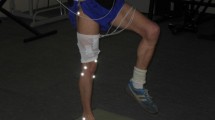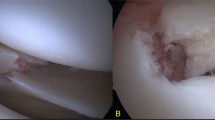Abstract
Introduction
The purpose of this study was to monitor the muscular changes regarding the isokinetic strength and torque pattern of the quadriceps femoris at the stable athlete’s knee after meniscus tear refixation.
Materials and methods
Therefore 15 athletes (10 male, 5 female) performing recreational or competitional sports at least five times a week before injury were retrospectively examined in the average 2.5 years after isolated arthroscopic meniscus refixation using Inside Out technique. Next to function and sport activity focused scores the isokinetic peak torque (PT) and in the EMG have been analyzed compared to the uninjured knee.
Results
The mean age was 31.26 years. The time between injury and surgery was in the average 13.7 days. According to our first results the data suggest a complete recovery of functional and muscular pattern after meniscus refixation at the stable athlete’s knee. No significant EMG changes for quadriceps femoris were detectable. The PT was fully recovered. The functional and sport activity score analysis (Lysholm and Tegner score) showed no changes in the postoperative long-term follow up compared to the preinjured status.
Conclusion
Examining isokinetic PT and the EMG of the quadriceps femoris, these data show no side-to-side differences. Regarding the function and sports activity score system, the functionally high demand patients seem to profit by this procedure.
Similar content being viewed by others
References
Barber FA, Herbert MA (2000) Meniscal repair devices. Arthroscopy 16:613–618
Becker R, Berth A, Nehring M, Awiszus F (2004) Neuromuscular quadriceps dysfunction prior to osteoarthritis of the knee. J Orthop Res 22:768–773
Becker R, Brettschneider O, Grobel KH, von Versen R, Starke C (2006) Distraction forces on repaired bucket-handle lesions in the medial meniscus. Am J Sports Med 34:1941–1947
Borner CE, Ruhmann O, Hehl S, Wirth CJ, Bohnsack M (2005) Treatment of incomplete meniscal lesions in athletes. Sportverletz Sportschaden 19:200–204
Courtney CA, Rine RM (2006) Central somatosensory changes associated with improved dynamic balance in subjects with anterior cruciate ligament deficiency. Gait Posture 24:190–195
DeHaven KE, Black KP, Griffiths HJ (1989) Open meniscus repair. Technique and two to nine year results. Am J Sports Med 17:788–795
DeHaven KE, Lohrer WA, Lovelock JE (1995) Long-term results of open meniscal repair. Am J Sports Med 23:524–530
Drechsler WI, Cramp MC, O.M. S (2006) Changes in muscle strength and EMG median frequency after anterior cruciate ligament reconstruction. Eur J Appl Physiol 98:613-623
Durand A, Richards CL, Malouin F (1991) Strength recovery and muscle activation of the knee extensor and flexor muscles after arthroscopic meniscectomy. A pilot study. Clin Orthop Relat Res 262:210–226
Durselen L, Schneider J, Galler M, Claes LE, Bauer G (2003) Cyclic joint loading can affect the initial stability of meniscal fixation implants. Clin Biomech (Bristol, Avon) 18:44-49
Dye SF, Wojtys EM, Fu FH, Fithian DC, Gillquist I (1999) Factors contributing to function of the knee joint after injury or reconstruction of the anterior cruciate ligament. Instr Course Lect 48:185–198
Ellermann A, Bülow JU, Siebold R, Bös L (2001) Expertenmeinung: Meniskusrefixation. Arthroskopie 14:278–279
Elmqvist LG, Lorentzon R, Johansson C, Fugl-Meyer AR (1988) Does a torn anterior cruciate ligament lead to change in the central nervous drive of the knee extensors? Eur J Appl Physiol Occup Physiol 58:203–207
Ericsson YB, Roos EM, Dahlberg L (2006) Muscle strength, functional performance, and self-reported outcomes four years after arthroscopic partial meniscectomy in middle-aged patients. Arthritis Rheum 55:946–952
Fink C (2001) Meniskusrefixation–Anatomische und biologische Grundlagen. Arthroskopie 14:248–253
Freiwald J, Jäger A, Starker M (1993) EMG-assisted functional analysis within the scope of follow-up of arthroscopically managed injuries of the anterior cruciate ligament. Sportverletz Sportschaden 7:122–128
Gapeyeva H, Paasuke M, Ereline J, Pintsaar A, Eller A (2000) Isokinetic torque deficit of the knee extensor muscles after arthroscopic partial meniscectomy. Knee Surg Sports Traumatol Arthrosc 8:301–304
Haas AL, Schepsis AA, Hornstein J, Edgar CM (2005) Meniscal repair using the FasT-Fix all-inside meniscal repair device. Arthroscopy 21:167–175
Herzog W, Suter E (1997) Muscle inhibition following knee injury and disease. Sportverletz Sportschaden 11:74–78
Hurley MV, Jones DW, Newham DJ (1994) Arthrogenic quadriceps inhibition and rehabilitation of patients with extensive traumatic knee injuries. Clin Sci (Lond) 86:305–310
Jäger A, Khoudeir S, Braune C, Herresthal J (2002) Can meniscal suture repair in athletes prevent early development of osteoarthritis without compromising the preinjury sports activity level. Sportverletz Sportschaden 16:70–73
Jerosch J, Riemer S (2004) How good are clinical investigative procedures for diagnosing meniscus lesions? Sportverletz Sportschaden 18:59–67
Kannus P, Jarvinen M (1989) Incidence of knee injuries and the need for further care. A one-year prospective follow-up study. J Sports Med Phys Fitness 29:321–325
Lysholm J, Gillquist J (1982) Evaluation of knee ligament surgery results with special emphasis on use of a scoring scale. Am J Sports Med 10:150–154
Matthews P, St-Pierre DM (1996) Recovery of muscle strength following arthroscopic meniscectomy. J Orthop Sports Phys Ther 23:18–26
McHugh MP, Tyler TF, Browne MG, Gleim GW, Nicholas SJ (2002) Electromyographic predictors of residual quadriceps muscle weakness after anterior cruciate ligament reconstruction. Am J Sports Med 30:334–339
Mikkelsen C, Werner S, Eriksson E (2000) Closed kinetic chain alone compared to combined open and closed kinetic chain exercises for quadriceps strengthening after anterior cruciate ligament reconstruction with respect to return to sports: a prospective matched follow-up study. Knee Surg Sports Traumatol Arthrosc 8:337–342
Moffet H, Richards CL, Malouin F, Bravo G, Paradis G (1998) Effects of the type of meniscal lesion on knee function. J Electromyogr Kinesiol 8:411–422
Morgan CD, Wojtys EM, Casscells CD, Casscells SW (1991) Arthroscopic meniscal repair evaluated by second-look arthroscopy. Am J Sports Med 19:632–638
Morrissey MC, Hooper DM, Drechsler WI, Hill HJ (2004) Relationship of leg muscle strength and knee function in the early period after anterior cruciate ligament reconstruction. Scand J Med Sci Sports 14:360–366
Muellner T, Egkher A, Nikolic A, Funovics M, Metz V (1999) Open meniscal repair: clinical and magnetic resonance imaging findings after twelve years. Am J Sports Med 27:16–20
Pujol N, Panarella L, Selmi TA, Neyret P, Fithian D, Beaufils P (2008) Meniscal healing after meniscal repair: a CT arthrography assessment. Am J Sports Med 36:1489–1495
Rupp S, Seil R, Kohn D (2001) Ergebnisse nach Meniskusnaht—Literaturübersicht. Arthroskopie 14:267–275
Stam HJ, Binkhorst RA, Kuhlmann P, van Nieuwenhuyzen JF (1992) Clinical progress and quadriceps torque ratios during training of meniscectomy patients. Int J Sports Med 13:183–188
Swenson TM, Fu FH (1993) Anterior cruciate ligament reconstruction: long-term results using autograft tissue. Clin Sports Med 12:709–722
Tandogan RN, Taser O, Kayaalp A, Taskiran E, Pinar H, Alparslan B, Alturfan A (2004) Analysis of meniscal and chondral lesions accompanying anterior cruciate ligament tears: relationship with age, time from injury, and level of sport. Knee Surg Sports Traumatol Arthrosc 12:262–270
Tegner Y, Lysholm J (1985) Rating systems in the evaluation of knee ligament injuries. Clin Orthop Relat Res 198:43–49
Tuckman DV, Bravman JT, Lee SS, Rosen JE, Sherman OH (2006) Outcomes of meniscal repair: minimum of 2-year follow-up. Bull Hosp Jt Dis 63:100–104
Urbach D, Nebelung W, Weiler HT, Awiszus F (1999) Bilateral deficit of voluntary quadriceps muscle activation after unilateral ACL tear. Med Sci Sports Exerc 31:1691–1696
Urbach D, Nebelung W, Roepke M, Becker R, Awiszus F (2000) Bilateral dysfunction of the quadriceps muscle after unilateral cruciate ligament rupture with concomitant injury central activation deficit. Unfallchirurg 103:949–955
Venkatachalam S, Godsiff SP, Harding ML (2001) Review of the clinical results of arthroscopic meniscal repair. Knee 8:129–133
Author information
Authors and Affiliations
Corresponding author
Rights and permissions
About this article
Cite this article
Stein, T., Mehling, A.P., Jost, K. et al. Measurements of the quadriceps femoris function after meniscus refixation at the stable athlete’s knee. Arch Orthop Trauma Surg 129, 1063–1069 (2009). https://doi.org/10.1007/s00402-009-0852-6
Received:
Published:
Issue Date:
DOI: https://doi.org/10.1007/s00402-009-0852-6




